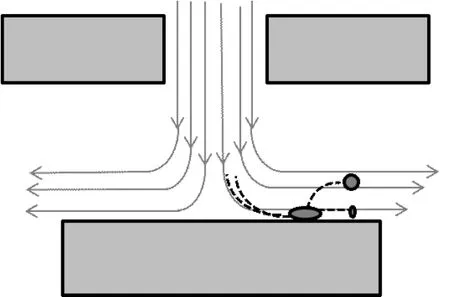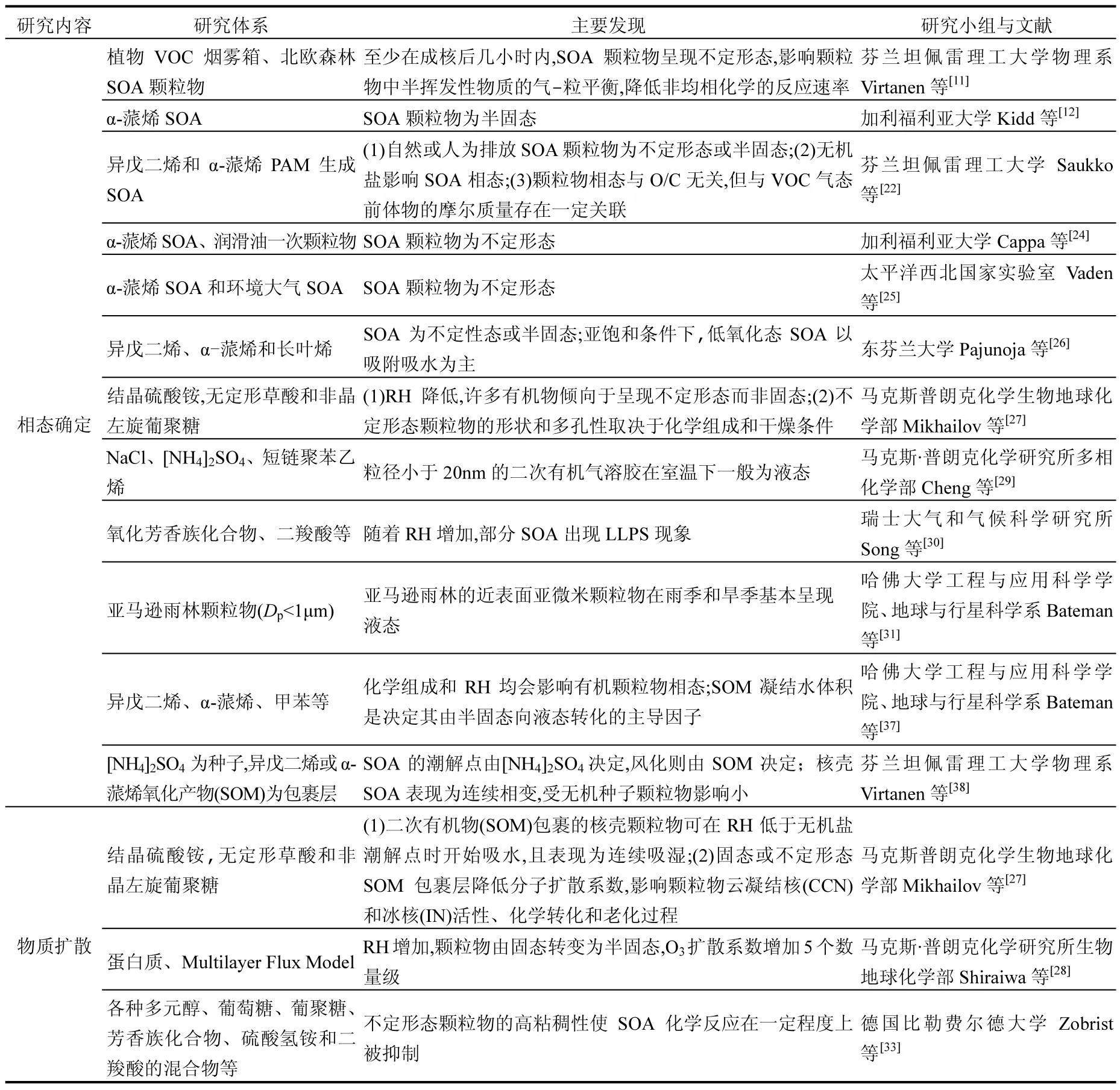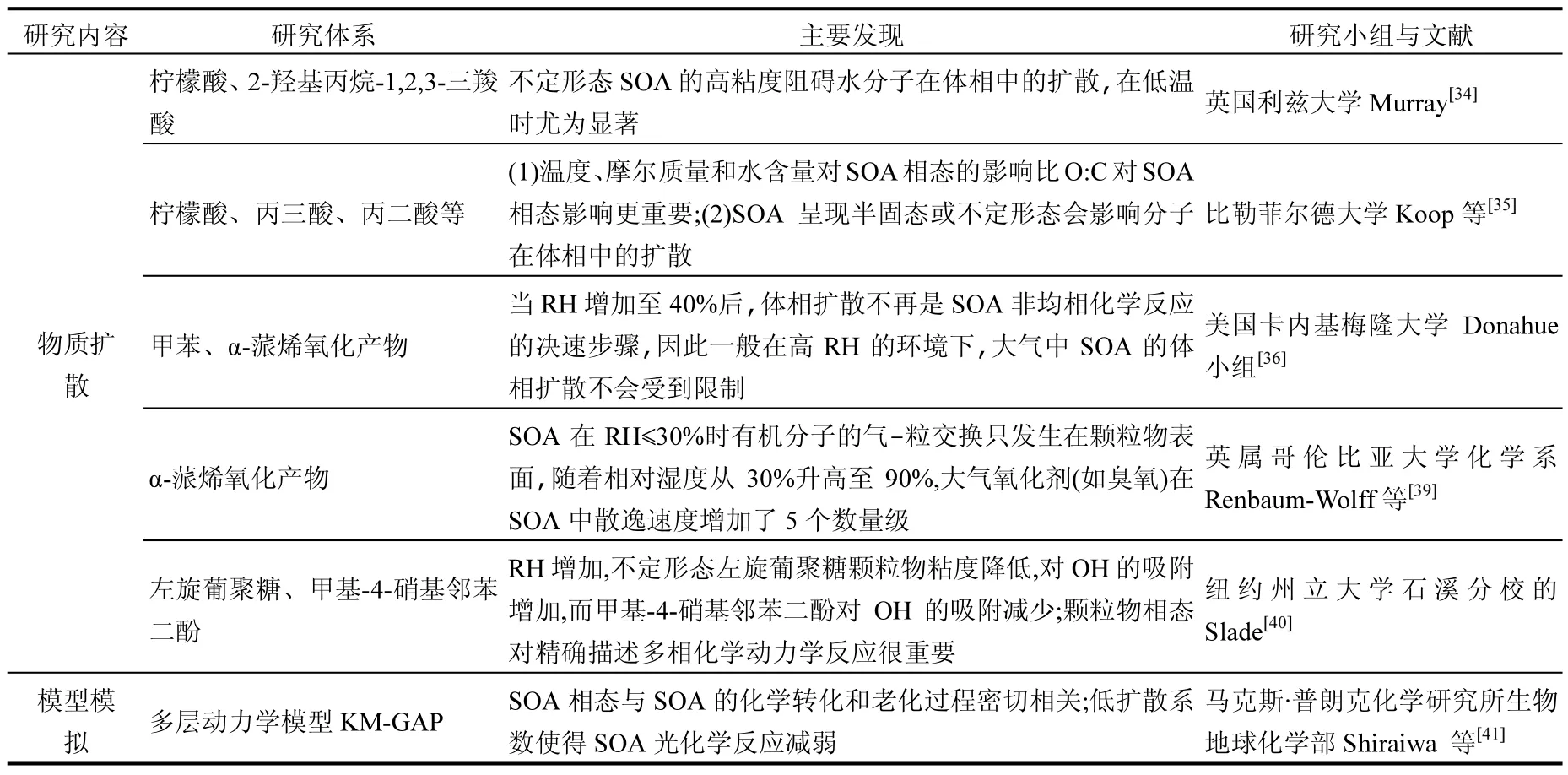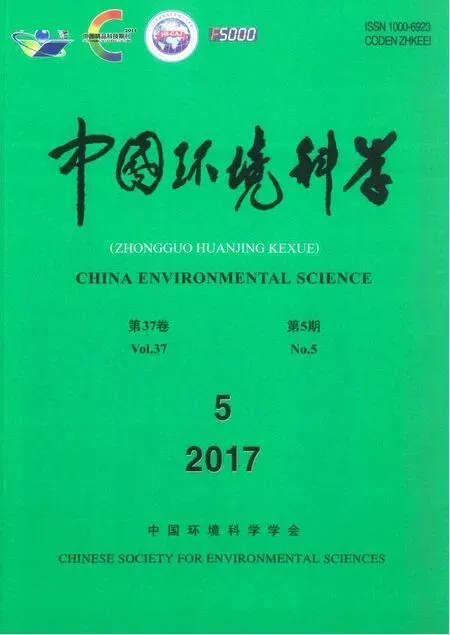二次有機氣溶膠相態的研究現狀與展望
劉玥晨,吳志軍,胡 敏 (北京大學環境科學與工程學院,環境模擬與污染控制國家重點聯合實驗室,北京100871)
二次有機氣溶膠相態的研究現狀與展望
劉玥晨,吳志軍*,胡 敏 (北京大學環境科學與工程學院,環境模擬與污染控制國家重點聯合實驗室,北京100871)
總結了國內外對二次有機氣溶膠(SOA)相態的研究進展,結果顯示不同條件下SOA可能是固態、不定形態、液態.固態和不定形態SOA的體相擴散系數遠低于液態SOA,從而阻礙SOA的物質傳輸和化學轉化等物理化學過程.目前,SOA相態的研究主要集中在有限體系,例如α-蒎烯、異戊二烯、甲苯等揮發性有機物為前體物產生的SOA,缺乏實際大氣SOA的相態信息.此外,對無機鹽影響SOA相態的認識也十分有限.本文提出重污染形成過程中,相態可能是二次顆粒物快速增長、轉化的重要影響因素之一.因此,結合外場觀測、實驗室研究以及多層動力學模型研究重污染形成過程中SOA的相態及其對關鍵反應活性氣體的吸附、傳輸等影響機制,有助于深入理解我國復合大氣污染條件下二次顆粒物的生成轉化機制.
二次有機氣溶膠(SOA);相態;粘度;擴散系數
二次有機氣溶膠(SOA)在大氣顆粒物中的占比可達 20%~90%[1].在我國,碳質氣溶膠占PM2.5比值平均為 30%,城市地區遠高于其它地區[2].以北京為例, SOA的背景濃度約為2μg/m3,二次有機碳對大氣總有機碳的貢獻占比為20%~50%[3].SOA對區域空氣質量和全球氣候的影響十分顯著[4].但目前對SOA生成機制和環境效應的認識仍然十分有限.相態作為 SOA的一個重要性質,與 SOA生成機制和環境行為密切相關.
因此,針對 SOA相態的研究有助于推進對SOA生成機制的深入理解[5].
物質存在時的物理狀態稱為相態[6].根據粘度可以將顆粒物分為液態(粘度<102Pa?s)、半固態(102~1012Pa?s)和固態(>1012Pa?s).目前在大氣模型中SOA被普遍認為是一種低粘度的液態顆粒物,它能與周圍的氣體達到平衡且在時間尺度上沒有冷凝相的擴散限制[7-9].然而,有研究指出SOA 的相態并不能簡單的假定為液態[1,9-10],而可能是其他相態[11].
水作為顆粒物的塑化劑[12],可以改變顆粒物的相態與表面結構[13].因此,在低相對濕度(RH)下,SOA可能以固態形式存在,隨著 RH增加SOA可以成為類似“蜂蜜”狀膠體,RH繼續增加SOA成為液態[14].不同相態會直接影響氣態分子在SOA界面和體相傳輸、半揮發性物質的氣-粒平衡和SOA表界面化學反應[15]等過程,是決定多相反應速率的關鍵因素之一[16-17].因此精確表征SOA相態以及深入理解相態對氣態分子吸附和散逸的影響是弄清SOA表面和體相反應的基礎.
本文針對SOA相態的測量技術手段和目前的主要研究成果進行歸納和總結,并對未來SOA相態測量與研究進行展望.
1 SOA相態的研究進展
1.1 相態測量的技術手段
SOA相態的測量技術主要基于顆粒物撞擊器原理,通過測定計算 SOA的彈跳系數(BF),推斷SOA相態.顆粒物撞擊器的主要原理(圖1):顆粒物的質量遠大于氣體分子,當氣流以一定的速度流動時,遇到障礙物,氣流中質量較大的顆粒物由于慣性保持原有運動狀態從而與障礙物發生碰撞,其余顆粒物則隨氣體改變流動方向,繞過障礙物繼續運動.研究發現碰撞發生后并非所有的顆粒物都會粘附于障礙物表面,當顆粒物的動能足以克服顆粒物與障礙物之間的粘附力時,顆粒物會發生彈跳再次回到氣流當中隨之流動.這一現象過去被看作是難以攻克的系統誤差,例如,在測定顆粒物的質量粒徑分布譜時,撞擊板上的顆粒物質量會由于彈跳現象產生誤差[18-19].近年來有研究發現顆粒物的彈跳與其相態密切相關[11].固態顆粒物在發生碰撞時產生的粘附力遠小于液態顆粒物,因此固態顆粒物的彈跳更為明顯.基于該現象,假定在顆粒物撞擊器中,固態顆粒物發生彈跳,而液態顆粒物直接粘附在撞擊板上[11,20-23].

圖1 顆粒物撞擊器原理Fig.1 A schematic diagram of an impactor
測定顆粒物相態的撞擊器主要有兩種 ,分別是電氣低壓撞擊器(ELPI)和三通道顆粒物相態測定儀.其中由芬蘭坦佩雷理工大學 Saukko等[20,22]改進使用的 ELPI是第一臺用于測定顆粒物相態的儀器.該儀器可用于區分物質的固態、不定形態和液態.但其內部存在較大的壓力降,導致設定的空氣動力學切割粒徑與實際數值可能存在較大偏差;此外,撞擊器上級的壓力遠低于實際大氣,因此它能達到的最大相對濕度(RH)僅為 66%.顆粒物與撞擊板碰撞時的粘附力與RH密切相關,因此它在RH的控制方面并不能完全滿足研究需要.相比之下,哈佛大學Bateman等[21]設計的三通道顆粒物相態測定儀避免了撞擊器的上級壓力降,使其壓力接近于實際大氣,在一定程度上保證了實際切割粒徑與設定值一致,并且RH最高可達100%.此外,三通道顆粒物相態測定儀通過并聯平行測量,提高了顆粒物彈跳系數的測量準確度和精度.該系統可進行在線連續測定,時間分辨率為 1s.但三通道顆粒物相態測定儀為單級撞擊器,因此只能單次測定單一粒徑范圍內的顆粒物相態.總而言之,目前這些儀器能夠進行顆粒物相態的離線和在線測定,但它們仍需要不斷的發展以滿足各種研究的需要.
1.2 國際上相態的研究進展
表1總結了目前國際上針對SOA相態的主要研究體系、重要發現、以及相應的研究小組.下面對表中總結的內容從相態的確定、物質擴散、模型模擬3個方面進行討論.
1.2.1 相態的確定 芬蘭坦佩雷理工大學Virtanen等[11]通過分析植物源揮發性有機物氧化生成的SOA的彈跳系數發現,與現有模型假設SOA為液態不同,此類 SOA為無定形態.此后,Cappa[24]、Vaden[25]和Pajunoja等[26]也相繼給出相同的結論.2012年,Saukko等[22]研究發現自然(如異戊二烯、α-蒎烯和長葉烯)或人為排放揮發性有機物(VOC)(如萘和正十七烷)生成的SOA為不定形態或半固態;無機鹽(如硫酸鹽)會使 SOA更容易以液態存在;SOA相態與氧碳比(O/C)無關,但與 VOC氣態前體物的摩爾質量存在一定關聯.同樣的,Mikhailov等[27]研究發現許多有機物質,例如羧酸、碳水化合物和蛋白質,在RH降低過程中最終往往形成不定形態顆粒物,而非固態.德國馬普所Shiraiwa等[28]對蛋白質顆粒物的研究發現,隨著 RH的增加顆粒物由固態轉變為半固態.Cheng等[29]在對短鏈聚苯乙烯生成的顆粒物進行研究后發現粒徑小于 20nm的SOA在室溫下一般為液態.SOA形成時的環境大氣 RH對其相態也存在一定的影響,例如,Kidd等[12]發現,SOA生成時的RH越高,顆粒物粘度越低,羧酸含量增加而相對分子質量高的化合物減少;而在干燥條件下生成的SOA,即使隨后RH大幅上升,仍能保持固態.此外,Song等[30]發現隨著RH的上升,無機相-有機相混合體系以及部分純有機相 SOA(例如:檸檬烯、石竹烯等)會發生液相-液相分離(LLPS)現象,即SOA形成兩層液相,內部為富水液相核,外部為富有機相液相層. Saukko等[22]指出,LLPS現象發生后,內部的液相核可能始終保持液態,并增加 SOA的吸水能力,而外部的富有機物液相層的相態則隨著外部條件的改變,可能以液態、半固態或固態存在.
目前針對實際大氣顆粒物,尤其是針對SOA 相態測量的結果仍然很少.Virtanen等[11]對北歐森林大氣中顆粒物的研究表明至少在成核的幾個小時內顆粒物為固態.而哈佛大學Bateman等[31]對粒徑小于1μm的亞馬遜雨林大氣中顆粒物相態的測定結果表明,亞微米顆粒物在雨季和旱季基本呈現液態,與Virtanen等[11]在北歐森林地區測定的結果不同.由于化學組成和RH均會影響有機顆粒物相態,因此這一差異可能是由北歐森林和亞馬遜森林顆粒物化學組成不同造成的.
結合上述實驗室生成和實際大氣SOA相態的測定結果,SOA不能簡單的定義為低粘度的液態顆粒物,其相態與RH密切相關.多數情況下,低RH時SOA一般呈現固態,隨著RH的增加, SOA可以呈現不定形態或半固態,達到一定RH條件后,SOA可能成為液態顆粒物.SOA化學組分也對其相態有一定的影響,尤其當 SOA中混合無機鹽后會使 SOA偏向于液態.總而言之, SOA的相態呈現多種形式,需要更深入的研究對其進行探討.
1.2.2 物質擴散 顆粒物與氣態分子之間,以及顆粒物內部均存在物質的吸附、散逸和化學轉化,而相態對這些過程的影響十分顯著.早在2007年就有研究發現水分子由表面傳輸至體相的擴散速率在固體顆粒物中遠高于不定形態顆粒物,因此固體顆粒物更容易被活化,同時由于顆粒物體相化學物質的傳輸和擴散是顆粒物化學反應的決速步驟,不定形態顆粒物的粘稠性會使顆粒物的化學反應在一定程度上被阻礙[32-33].之后, Murray[34]、Mikhailov[27]和Koop[35]等均發現,水分子在粘稠顆粒物體相中的擴散速率會極大地降低甚至可被完全抑制,特別是在低溫條件下,這一現象更加顯著.另一方面,德國馬普所Shiraiwa等[16]發現由于蛋白質顆粒物相態的變化導致在RH從20%增加至100%時,臭氧的擴散系數由 10?10cm2/s增加為 10?5cm2/s.Mikhailov等[27]對核殼 SOA的研究發現固態或不定形態二次有機物包裹層會降低分子擴散系數,影響SOA云凝結核和冰核活性,以及化學轉化和老化過程.英屬哥倫比亞大學研究小組從顆粒物粘度的角度分析發現SOA在RH≤30%時有機分子的氣-粒交換只發生在顆粒物表面,隨著相對濕度從30%升高至90%,大氣氧化劑(如O3)在SOA中散逸速度增加了 5個數量級[14].此外,芬蘭坦佩雷理工大學 Virtanen等[11]的研究發現不定形態可以影響顆粒物中半揮發性物質的氣-粒平衡,降低非均相化學的反應速率.因此,在低相對濕度下固態顆粒上的化學反應受表面限制,即非均相反應只能發生在顆粒物表面,而在高相對濕度下液態顆粒物的化學反應可以發生在體相[15-16].Ye等[36]的最新研究也支持了這一觀點.他們通過實驗發現,當RH增加至40%后,體相擴散不再是 SOA非均相化學反應的決速步驟,因此一般在高RH的環境下,大氣中SOA的體相擴散不會受到限制.這一現象可能與SOA在高RH時相態發生轉變有關.總而言之,物質在固態、半固態或不定形態SOA體相中的擴散可能會受到抑制,從而對SOA的物質傳輸、化學轉化和老化過程等造成顯著影響.

表1 SOA相態國際研究進展Table 1 Progress in SOA phase state in the world

續表1
1.2.3 模型模擬 如前文所述,物質傳輸、擴散和轉化過程會在SOA的表面和體相發生,為了對這些過程進行模擬,P?schl等[42]在電阻模型的基礎上建立了PRA動力學模型,提出了雙表層概念和通用速率方程,打破了傳統電阻模型存在的諸多限值條件(例如 SOA均相混合,所含的惰性化學種類有限等).之后,在 PRA 模型的基礎上, Shiraiwa等[41]建立了多層動力學模型KM-GAP,該模型也將SOA進行分層以研究其中的物理化學過程,但不同的是,KM-GAP對SOA的分層更加精細,分別為吸附層、亞穩態表層、近表層和多層體相層,其中吸附層和亞穩態表層均為單分子層,其厚度等于半揮發性有機物分子的平均有效直徑,同時SOA周圍的大氣層則被分為氣相層和SOA近表面氣相層.KM-GAP可對SOA的氣相擴散、氣-粒交界面傳輸(可逆吸附)、表層化學反應、表面-體相傳輸、體相擴散和體相化學反應過程進行模擬.
低擴散系數是高粘度或半固態物質的特征.利用 KM-GAP模型,Shiraiwa等[41]針對相態對SOA的物質傳輸過程的影響進行了研究.結果顯示,固態和半固態SOA中有機物被大氣光化學氧化物降解的過程受到了極大地抑制,該結果與前人實驗結果一致[32-33].不同體相擴散系數的敏感性研究結果表明SOA相態與SOA的化學轉化和老化過程密切相關[41].
綜上所述,作為反應載體的大氣顆粒物,其相態和微觀尺度下的表面物理和化學性質與分子吸附、擴散以及化學過程密切相關.相關國際研究指出,對SOA相態的深入研究可能會改變對顆粒物二次轉化過程的傳統認識,進而推進對二次顆粒物生成機制的理解.SOA是極其復雜的體系,面對如此復雜的研究對象,現階段亟需多學科的有效結合,引入新的技術手段.目前極少數幾個國際研究小組,包括芬蘭坦佩雷理工大學 Virtanen小組、哈佛大學 Martin小組、英屬哥倫比亞大學Bertrama小組、馬普所P?schl小組等[42],近期在該領域開展了相應工作,其研究主要集中在有限的顆粒物類型,包括蛋白質、蒎烯臭氧氧化產物的相態表征及其對反應活性氣體的吸附和擴散的影響機制,缺乏實際大氣SOA相態及其與無機鹽離子、表面活性物質的相互作用機制研究.
1.3 我國研究進展
我國區域性大氣污染日益嚴峻,對人類健康、經濟發展以及區域氣候產生顯著影響,已經成為我國目前面臨的重要環境問題[43].高濃度的二次顆粒物是造成區域性大氣污染的一個重要因素[44-45].研究發現氣相或液相化學反應機制無法解釋目前所觀測到的高濃度二次顆粒物快速生成和增長,而大氣顆粒物的非均相轉化過程可能在重度污染形成中起到重要作用[46-49].如前所述,SOA作為反應載體,其相態、表面性質可直接影響非均相反應等多種化學過程.重污染形成過程中,SOA相態和表面性質可能是二次顆粒物快速增長、轉化的重要因素之一.因此,研究細粒子爆發性增長過程中SOA的相態、化學與表面性質及其對關鍵反應活性氣體的吸附、傳輸等影響機制對深入理解我國復合大氣污染條件下二次顆粒物爆發生成與增長機制極其重要.
目前我國對顆粒物相態,尤其是對SOA相態的研究十分薄弱,現有工作大多集中在顆粒物吸濕活化的宏觀研究.例如,在北京[50]、上海[51]、珠三角[52]、華北地區[53-54]等地開展了顆粒物吸濕活化的外場觀測及其含水量的估算[55];也開展了實驗室研究[56-57].盡管SOA相態與其吸濕性、含水量密切相關,但吸濕性并不能反映相態的真實信息.由此可見,目前我國尚缺乏表征大氣復合污染條件下SOA相態的關鍵參數,亟需開展相關研究獲取SOA相態信息.
在我國大氣復合污染中同時存在高濃度的一次排放和二次轉化的氣態及顆粒污染物, 這為SOA表面非均相反應提供了充足的反應物[58].已有研究表明以SOA作為反應載體的多相化學過程的重要性,但由于缺乏SOA相態的相關信息,目前模型模擬只能假定SOA為液態[7-9].同時,觀測已經發現我國SOA中含有大量的表面活性物質(類腐殖質 HULIS)[59-60],這類表面活性物質可以改變SOA吸水機制,進而改變SOA含水量和相態,而目前仍缺乏表面活性物質-水-相態的相互作用機制的認識.
如上所述,SOA相態和表面性質對其表面或體相的化學過程影響十分顯著,而目前仍缺乏描述大氣復合污染條件下SOA作為反應載體的特征參數及其對關鍵反應活性氣體二次轉化的影響機制,阻礙了深入理解復合大氣污染條件下SOA快速增長過程和機理.此外,無機鹽的存在可能會對 SOA的相態造成較大影響[38],而含有大量無機鹽成分恰恰是我國重污染過程中二次顆粒物化學組分的主要特征.因此,有必要在我國大氣復合污染條件下開展相關研究,為深入研究我國霾形成機制提供必要信息.
2 研究展望
當前我國大氣復合污染嚴重,SOA相態的關鍵參數卻極為缺乏.結合我國復雜的大氣污染過程,未來SOA相態關注的主要科學問題應該包括:①不同大氣污染條件下SOA相態是什么?②相態在大氣顆粒物污染中是否為關鍵因素?③無機鹽對SOA相態的影響如何?④相態對SOA的氣態分子攝取系數及多相化學反應速率的影響程度和機制如何?針對以上問題,為全面了解我國實際大氣環境中不同污染情況下SOA的相態及其環境效應,未來相關研究應結合外場宏觀測量、微觀光譜測量和理論化學模擬,以精確表征SOA相態、表界面結構及其微觀吸附過程,并量化其對大氣中關鍵氣態前體物分子吸附和散逸的影響.從微觀機制入手理解氣-粒作用機制,為模型模擬多相化學過程提供關鍵參數,促進對二次顆粒物形成機制及增長機制的深入理解.
3 結論
3.1 當前 SOA相態的測量技術一般基于顆粒物撞擊器原理,通過測定彈跳系數推斷SOA相態.主要的測量儀器包括ELPI和三通道顆粒物相態測定儀.
3.2 SOA作為反應載體,其相態對其表面或體相的化學過程影響十分顯著.近年來,國際上已經展開的 SOA相態實驗室研究和外場觀測均表明,SOA的物質形態并不是單一的以液態,還可能以固態、半固態或不定形態等存在.當SOA為固態、半固態或不定形態時,其體相中物質傳輸和化學轉化等物理化學過程均會受到不同程度的抑制.然而,目前,這些研究均主要集中有限的有機體系,針對無機鹽影響SOA相態的研究不足.此外,目前國際上僅有兩次二次顆粒物相態外場觀測,因此增加SOA相態外場測量頻次必不可少,同時SOA相態的測量技術手段也仍需優化.
參考文獻:
[1] Hallquist M,Wenger J,Baltensperger U, et al. The formation, properties and impact of secondary organic aerosol: current and emerging issues [J]. Atmospheric Chemistry and Physics, 2009, 9(14):5155-5236.
[2] Zheng J, Hu M, Peng J, et al. Spatial distributions and chemical properties of PM2.5based on 21 field campaigns at 17sites in China [J]. Chemosphere, 2016,159:480.
[3] Guo S, Hu M, Guo Q, et al. Primary Sources and Secondary Formation of Organic Aerosols in Beijing, China [J]. Environmental science & technology, 2012,46(18):9846-9853.
[4] Chang I C. The Physical Science Basis. Working Group I Contribution to the Fourth Assessment Report of the IPCC [R]. 2007.
[5] Koop T, Bookhold J, Shiraiwa M, et al. Glass transition and phase state of organic compounds: dependency on molecular properties and implications for secondary organic aerosols in the atmosphere [J]. Physical Chemistry Chemical Physics, 2011,13(43):19238-19255.
[6] Martin S T. Phase Transitions of Aqueous Atmospheric Particles [J]. Chemical Reviews, 2000,100(9):3403-3454.
[7] Kidd C, Perraud V, Wingen L M, et al. Integrating phase and composition of secondary organic aerosol from the ozonolysis of α-pinene [J]. Proceedings of the National Academy of Sciences, 2014,111(21):7552-7557.
[8] Donahue N M, Robinson A L, Stanier C O, et al. Coupled Partitioning, Dilution, and Chemical Aging of Semivolatile Organics [J]. Environmental science & technology, 2006,40(8): 2635-2643.
[9] Pankow J F. An absorption model of gas/particle partitioning of organic compounds in the atmosphere [J]. Atmospheric Environment, 1994,28(2):185-188.
[10] Jimenez J, Canagaratna M, Donahue N, et al. Evolution of organic aerosols in the atmosphere [J]. Science, 2009,326(5959): 1525-1529.
[11] Virtanen A, Joutsensaari J, Koop T, et al. An amorphous solid state of biogenic secondary organic aerosol particles [J]. Nature, 2010,467(7317):824-827.
[12] Kidd C, Perraud V, Wingen L M, et al. Integrating phase and composition of secondary organic aerosol from the ozonolysis of α-pinene [J]. Proceedings of the National Academy of Sciences of the United States of America, 2014,111(21):7552-7557.
[13] Shrestha M, Zhang Y, Upshur M A, et al. On surface order and disorder of α-pinene-derived secondary organic material [J]. The Journal of Physical Chemistry. A, 2015,119(19):4609-4617.
[14] Renbaum-Wolff L, Grayson J W, Bateman A P, et al. Viscosity of α-pinene secondary organic material and implications for particle growth and reactivity [J]. Proceedings of the National Academy of Sciences of the United States of America, 2013,110(20):8014-8019.
[15] Maria S F, Russell L M, Gilles M K, et al. Organic Aerosol Growth Mechanisms and Their Climate-Forcing Implications [J]. Science, 2004,306(5703):1921-1924.
[16] Shiraiwa M, Ammann M, Koop T, et al. Gas uptake and chemical aging of semisolid organic aerosol particles [J]. Proceedings of the National Academy of Sciences of the United States of America, 2011,108(27):11003-11008.
[17] George I J, Abbatt J P D. Heterogeneous oxidation of atmospheric aerosol particles by gas-phase radicals [J]. Nature Chemistry, 2010,2(9):713-722.
[18] Dzubay T G, Hines L E, Stevens R K. Particle bounce errors in cascade impactors [J]. Atmospheric Environment (1967), 1976, 10(3):229-234.
[19] Markowski G R. Reducing blowoff in cascade impactor measurements [J]. Aerosol Science and Technology, 1984,3(4): 431-439.
[20] Saukko E, Kuuluvainen H, Virtanen A. Amethod to resolve the phase state of aerosol particles [J]. Atmospheric Measurements and Technology, 2012,5(1):259-265.
[21] Bateman A P, Belassein H, and Martin S T. Impactor Apparatus for the Study of Particle Rebound: Relative Humidity and Capillary Forces [J]. Aerosol Science and Technology, 2014,48(1): 42-52.
[22] Saukko E, Lambe A T, Massoli P, et al. Humidity-dependent phase state of SOA particles from biogenic and anthropogenic precursors [J]. Atmospheric Chemistry and Physics, 2012,12(16): 7517-7529.
[23] Hinds W C. Aerosol Technology: Properties, Behavior, and Measurement of Airborne Particles, 2nd Edition [B]. 2012.
[24] Cappa C D, Wilson K R. Evolution of organic aerosol mass spectra upon heating: implications for OA phase and partitioning behavior [J]. Atmospheric Chemistry and Physics, 2011,11(5): 1895-1911.
[25] Vaden T D, Imre D, Beránek J, et al. Evaporation kinetics and phase of laboratory and ambient secondary organic aerosol [J]. Proceedings of the National Academy of Sciences, 2011,108(6): 2190-2195.
[26] Pajunoja A, Lambe A T, Hakala J, et al. Adsorptive uptake of water by semisolid secondary organic aerosols [J]. Geophysical Research Letters, 2015,42(8):2015GL063142.
[27] Mikhailov E, Vlasenko S, Martin S T, et al. Amorphous and crystalline aerosol particles interacting with water vapor: conceptual framework and experimental evidence for restructuring, phase transitions and kinetic limitations [J].Atmospheric Chemistry and Physics, 2009,9(24):9491-9522.
[28] Shiraiwa M, Ammann M, Koop T, et al. Gas uptake and chemical aging of semisolid organic aerosol particles [J]. Proceedings of the National Academy of Sciences, 2011,108(27):11003-11008.
[29] Cheng Y, Su H, Koop T, et al. Size dependence of phase transitions in aerosol nanoparticles [J]. Nature Communications, 2015,6:5923.
[30] Song M, Marcolli C, Krieger U K, et al. Liquid-liquid phase separation in aerosol particles:Dependence on O:C, organic functionalities, and compositional complexity [J]. Geophysical Research Letters, 2012,39(39):677.
[31] Bateman A P, Gong Z, Liu P, et al. Sub-micrometre particulate matter is primarily in liquid form over Amazon rainforest [J]. Nature Geoscience, 2016,9(1):34-37.
[32] Zahardis J, Petrucci G A. The oleic acid-ozone heterogeneous reaction system: products, kinetics, secondary chemistry, and atmospheric implications of a model system & ndash; a review [J]. Atmoshepric Chemistry Physics, 2007,7(5):1237-1274.
[33] Zobrist B, Marcolli C, Pedernera D A. Do atmospheric aerosols form glasses? [J]. Atmoshepric Chemistry Physics, 8(17):5221-5244.
[34] Murray B J. Inhibition of ice crystallisation in highly viscous aqueous organic acid droplets [J]. Atmoshepric Chemistry and Physics, 2008,8(17):5423-5433.
[35] Koop T, Bookhold J, Shiraiwa M, et al. Glass transition and phase state of organic compounds: dependency on molecular properties and implications for secondary organic aerosols in the atmosphere [J]. Physical Chemistry Chemical Physics, 2011,13(43):19238-19255.
[36] Ye Q, Robinson E S, Ding X, et al. Mixing of secondary organic aerosols versus relative humidity [J]. Proceedings of the National Academy of Sciences, 2016,113(45).
[37] Bateman A P, Bertram A K, Martin S T. Hygroscopic influence on the semisolid-to-liquid transition of secondary organic materials [J]. The Journal of Physical Chemistry A, 2015,119(19): 4386-4395.
[38] Saukko E, Zorn S, Kuwata M, et al. Phase State and Deliquescence Hysteresis of Ammonium-Sulfate-Seeded Secondary Organic Aerosol [J]. Aerosol Science and Technology, 2015,49(7):531-537.
[39] Renbaum-Wolff L, Grayson J W, Bateman A P, et al. Viscosity of α-pinene secondary organic material and implications for particle growth and reactivity [J]. Proceedings of the National Academy of Sciences, 2013,110(20):8014-8019.
[40] Slade J H, Knopf D A. Multiphase OH oxidation kinetics of organic aerosol: The role of particle phase state and relative humidity [J]. Geophysical Research Letters, 2014,41(14):5297-5306.
[41] Shiraiwa M, Pfrang C, Koop T. Kinetic multi-layer model of gas-particle interactions in aerosols and clouds (KM-GAP): linking condensation, evaporation and chemical reactions of organics, oxidants and water [J]. Atmospheric Chemistry and Physics, 2012,12(5):2777-2794.
[42] P?schl U, Rudich Y, Ammann M. Kinetic model framework for aerosol and cloud surface chemistry and gas-particle interactions – Part 1: General equations, parameters, and terminology [J]. Atmospheric Chemistry and Physics, 2007,7(23):5989-6023.
[43] 賀 泓,王新明,王自發,等.大氣灰霾追因與控制 [J]. 中國科學院院刊, 2013,3:344-352.
[44] Huang R J, Zhang Y, Bozzetti C, et al. High secondary aerosol contribution to particulate pollution during haze events in China [J]. Nature, 2014,514(7521):218-222.
[45] Guo S, Hu M, Zamora M L, et al. Elucidating severe urban haze formation in China [J]. Proceedings of the National Academy of Sciences, 2014,111(49):17373-17378.
[46] Zheng B, Zhang Q, Zhang Y, et al. Heterogeneous chemistry: a mechanism missing in current models to explain secondary inorganic aerosol formation during the January 2013 haze episode in North China [J]. Atmospheric Chemistry and Physics, 2015, 15(4):2031-2049.
[47] Wang Y, Zhang Q, Jiang J, et al. Enhanced sulfate formation during China's severe winter haze episode in January 2013 missing from current models [J]. Journal of Geophysical Research: Atmospheres, 2014,119(17):10,425-10,440.
[48] Quan J, Tie X, Zhang Q, et al. Characteristics of heavy aerosol pollution during the 2012~2013 winter in Beijing, China [J]. Atmospheric Environment, 2014,88:83-89.
[49] He H, Wang Y, Ma Q, et al. Mineral dust and NOxpromote the conversion of SO2to sulfate in heavy pollution days [J]. Scientific Reports, 2014,4(1):4172.
[50] Wu Z J, Zheng J, Shang D J, et al. Particle hygroscopicity and its link to chemical composition in the urban atmosphere of Beijing, China during summertime [J]. Atmospheric Chemistry and Physics Discussion, 2015,15(8):11495-11524.
[51] Ye X, Ma Z, Hu D, et al. Size-resolved hygroscopicity of submicrometer urban aerosols in Shanghai during wintertime [J]. Atmospheric Research, 2011,99(2):353-364.
[52] LIU X G, Zhang Y, WEN M T, et al. A Closure Study of Aerosol Hygroscopic Growth Factor during the 2006Pearl River Delta Campaign [J]. Advanced Atmospheric Science, 2010,27(4):947-956.
[53] Duan J, Chen Y, Guo X L. Characteristics of aerosol activation efficiency and aerosol and CCN vertical distributions in North China [J]. Journal of Meteorological Research, 2012,26(5):579-596.
[54] Deng Z Z, Zhao C S, Ma N, et al. An examination of parameterizations for the CCN number concentration based on in situ measurements of aerosol activation properties in the North China Plain [J]. Atmospheric Chemisrtry and Physics, 2013, 13(13):6227-6237.
[55] Bian Y X, Zhao C S, Ma N, et al. A study of aerosol liquid water content based on hygroscopicity measurements at high relative humidity in the North China Plain [J]. Atmospheric Chemisrtry and Physics, 2014,14(12):6417-6426.
[56] Hu D, Chen J, Ye X, et al. Hygroscopicity and evaporation of ammonium chloride and ammonium nitrate: Relative humidity and size effects on the growth factor [J]. Atmospheric Environment, 2011,45(14):2349-2355.
[57] Lei T, Zuend A, Wang W G, et al. Hygroscopicity of organic compounds from biomass burning and their influence on the water uptake of mixed organic ammonium sulfate aerosols [J]. Atmospheric Chemisrtry and Physics, 2014,14(20):11165-11183.
[58] 朱 彤,尚 靜,趙德峰.大氣復合污染及灰霾形成中非均相化學過程的作用 [J]. 中國科學:化學, 2010,40(12):1731-1740.
[59] Lin P, Huang X F, He L Y, et al. Abundance and size distribution of HULIS in ambient aerosols at a rural site in South China [J]. Journal of Aerosol Science, 2010,41(1):74-87.
[60] Song J, He L, Peng P a, et al. Chemical and Isotopic Composition of Humic-Like Substances (HULIS) in Ambient Aerosols in Guangzhou, South China [J]. Aerosol Science and Technology, 2012,46(5):533-546.
Advances in the phase state of secondary organic aerosol.
LIU Yue-chen, WU Zhi-jun*, HU Min (State Key Joint Laboratory of Environmental Simulation and Pollution Control, College of Environmental Sciences and Engineering, Peking University, Beijing 100871, China). China Environmental Science, 2017,37(5):1637~1645
This review presents an overview of the analytical techniques for detecting the phase state of secondary organic aerosol (SOA), the effects of phase state on mass transport, and the types of SOA being studied. The previous studies showed that SOA could be solid, semi-solid, or liquid. The bulk diffusion coefficients for solid and semi-solid can be much smaller than those for liquid SOA, and therefore lead to limited mass transfer of species and different formation and transformation of SOA compared to liquid systems. However, only several types of SOA precursors have been studied, such as α-pinene, isoprene, and toluene. The phase state of SOA in urban areas as well as the effects of coexisting inorganic species on their phase state is largely unknown. Our analysis shows that the phase state perhaps play an important role in the rapid increase of secondary particle mass concentration during heavily hazed events. Therefore, it is important to study the phase state of SOA and the absorption and transfer of the key active gases at the surface and in the bulk of aerosols in the polluted environments, which will help us to further understand the mechanisms of the formation and evolution of secondary particles in China.
secondary organic aerosol (SOA);phase state;viscosity;diffusion coefficients
X513
A
1000-6923(2017)05-1637-09
劉玥晨(1993-),女,湖北宜昌人,北京大學博士研究生,主要從事大氣顆粒物相態及其對氣態污染物二次轉化研究.發表論文1篇.
《中國環境科學》再次獲評“RCCSE中國權威學術期刊(A+)”,位列學科榜首
2016-09-21
國家自然基金資助項目(41475127,41571130021,91544214, 21190052,41121004);國家“973”項目(2013CB228503);環境保護部公益項目(201409010);環境模擬與污染控制國家重點聯合實驗室專項經費資助項目(14L02ESPC)
* 責任作者, 研究員, zhijunwu@pku.edu.cn
《中國環境科學》在武漢大學中國科學評價研究中心發布的第四屆中國學術期刊評價中獲評“RCCSE中國權威學術期刊(A+)”.中國學術期刊評價按照各期刊的期刊學術質量和影響力指標綜合得分排名,將排序期刊分為A+、A、A-、B+、B、C 6個等級,評價的6201種中文學術期刊中有316種學術期刊獲評權威期刊(A+),A+為得分排名前5%的期刊.此次獲得“RCCSE中國權威學術期刊(A+)”稱號的環境類期刊有3種,《中國環境科學》在環境科學技術與資源科學技術學科內榮登榜首.

